24 Smart Shopping Habits That Will Save You Loads of Money in the Long Run

We all know the reality of shopping: You head to the store to pick up one thing, and somehow you end up at the cash register with a cartful of items you absolutely did not need. You intended on spending only $3 and yet you’re $75 in the hole. Retailers win, and it feels like you’ve lost. We understand the struggle—and we want to help you combat it. That’s why we’ve consulted retail and finance experts to get their best smart shopping habits that will save you loads of money in the long run. Read on for their simple tips.
READ THIS NEXT: Never Use Your Debit Card for These 6 Purchases, According to Financial Experts.
24 Smart Shopping Habits
1. Create a dedicated shopping checking account.

One way to budget is by creating a dedicated shopping checking account. “You can start contributing to it with each paycheck that’s deposited, and adjust based on your weekly or monthly budget,” suggests Courtney Alev, consumer financial advocate at Credit Karma.
“When you are out shopping, you know you have a set amount that you’re comfortable spending,” she explains. “And, once that money is gone, you know it’s time to stop spending.” Just be sure there are no fees associated with the account.
2. Leave your credit cards at home.
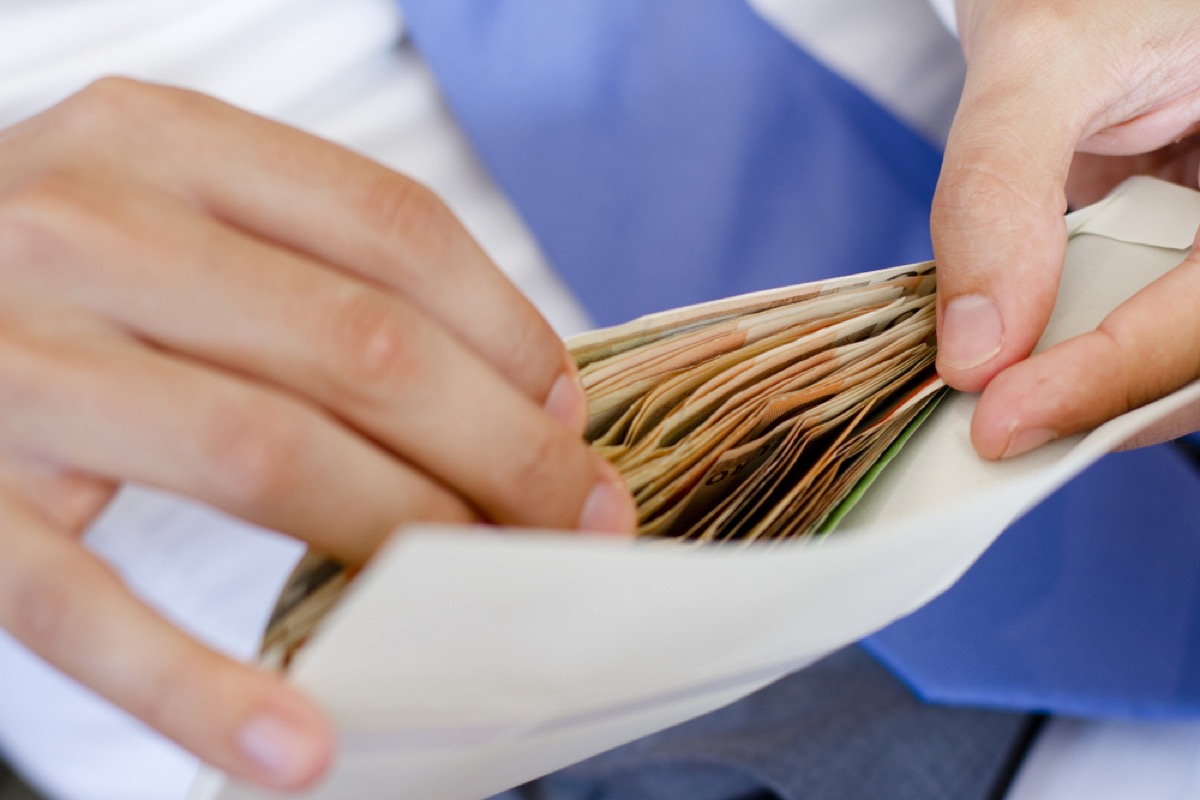
The psychology of credit cards means you’re more likely to overspend since the money isn’t actually coming out of your pocket just yet.
In fact, as NerdWallet points out, a well-cited 2001 study by professors at the Massachusetts Institute of Technology (MIT) found that “those who were told they would have to pay by credit card were willing to pay more than twice as much on average as those who were told that they would have to pay by cash.”
A simple way to combat this? Only keep your debit card or cash in your wallet when you’re going shopping.
3. Read reviews.

Just because an item is cheap, doesn’t mean it’s the best deal. If it breaks or doesn’t last, you’ll end up spending more to replace it. That’s why Michael Podolsky, CEO and co-founder of the consumer advocacy platform PissedConsumer.com, says it’s important to read product reviews.
“Not only do reviews serve as recommendations for a store or a product, but they also warn about poor quality and potential scams,” he explains. “Shoppers who check reviews before buying are far more likely to make an informed decision, avoid general unhappiness, and save money in the long run.”
4. Get stores’ apps.
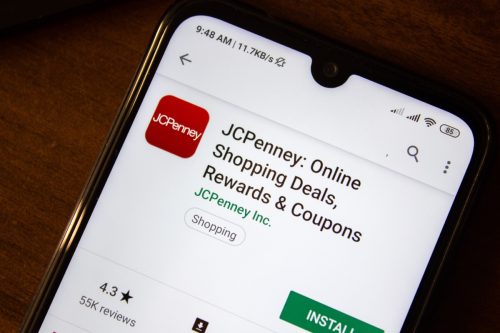
Rob Weisberg, EVP and president of the incentives and loyalty division at Inmar Intelligence, points out that many consumers don’t take advantage of all the coupons and sales available to them.
“In-store apps are a great place to start finding deals but consumers must take the time to download and use them when shopping,” he says.
READ THIS NEXT: Always Use Cash for These 5 Purchases, Financial Experts Say.
5. Stack coupons when you can.
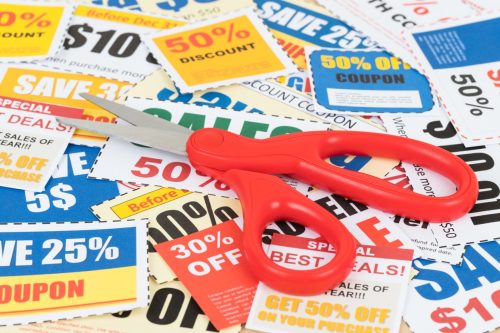
In many cases, stores will let you “stack” coupons, which means you can use more than one promotion on the same item.
“Most retailers and manufacturers will NOT allow a combination of both digital and paper coupons, so that is something to keep in mind for more industrious couponers,” notes Weisberg. “But shoppers can combine a coupon with an item already on sale in the store to maximize savings.”
6. Review receipts for coupons.

If we look at our receipts at all, we’re usually just making sure the prices are correct or throwing them in a pile until we’re sure we’re not returning anything. But money-saving expert Andrea Woroch says this might be a missed opportunity.
She shares that through receipts, she recently received a coupon for $5 off a $40 purchase at Sprouts and a 20 percent off coupon for Michael’s
“You can even turn receipts into cash back by taking pictures of them using the Fetch rewards app,” she adds.
7. Sign up for rewards and loyalty programs.

Signing up for retail rewards programs is so much easier in the digital age (no more wallets stuffed with cards!), and Hong Bloom, head of customer engagement and experience at TD Bank, says it’s definitely worth it—especially if you’ve already got the app.
“From DSW to Michaels Crafts and everything in between, you can often receive reward or bonus money on your purchase,” she notes. “Many of these stores offer birthday discounts as well if you are looking to save up for a bigger purchase!”
8. And sign up for special rebate programs.

There are quite a few ways to actually make money just by going about your shopping as you normally would.
If you love shopping online, Rakuten can get you cash back by shopping on hundreds of sites. And if you prefer the brick-and-mortar experience, Ibotta is a free shopping app that rewards customers with cash back simply for buying certain products and providing proof of purchase.
Another popular app is Shopkick, which “rewards you with points (called ‘kicks’) that you can use to redeem for free gift cards to your favorite grocery retailers, including Target and Walmart, in addition to other leading retailers like Amazon, Sephora, Best Buy and many more,” explains the company’s SVP and head of partnerships Brad Godwin.
Godwin adds that Shopkick can be used whether you’re shopping in-store or online, and it gives you points even if you don’t buy something but watch in-app recipe videos or scan items in stores.
READ THIS NEXT: Never Use Your Credit Card for These 6 Purchases, According to Financial Experts.
9. Refer a friend.

As a sales tactic to increase their reach, many companies will offer a refer-a-friend discount.
“You’ll get a unique link that you can email, text, or [share] on social media and then get credit towards the future purchase or money deposited into your account,” explains Woroch. “Plus, your friend or family member will also get something using your link.”
“For example, Away Luggage offers ‘Give $20, Get $20’ and the Dosh cash back app gives $10 per referral, which gets deposited into your account for use towards a purchase,” she adds.
10. Sell unwanted gift cards.
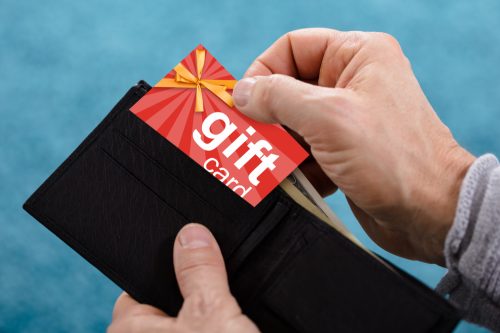
Let’s say you received a Target gift card, but there’s not a store close by your house or you just don’t like their products. Through sites like Raise and Card Cash, you can sell unwanted gift cards for cash or trade them in for gift cards you’ll actually use.
“You’ll get up to 92 percent of the value of the gift card as cash,” Woroch explains. You’ll get a better value if you do check or PayPal or “if you just swap it for a gift card to a different store or restaurant.”
11. Walk the aisles.

Sometimes, the smartest ways to save are the simplest. Godwin recommends walking store aisles to scope out the best prices.
“As inflation continues to impact grocery costs, it is easy for shoppers to fall for the oldest trick in the book—buying items at the corners of each aisle,” he explains. “However, items on the corners are often more expensive than getting the same one placed down the row. It only takes walking a couple more feet to save dollars on your goods.”
12. Use self-checkout.
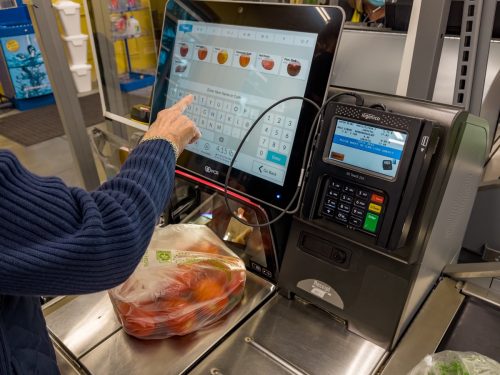
For this tip, Woroch points to a 2007 study conducted by IHL Consulting Group. According to Supermarket News, the study found that, on average, “impulse purchases made by women drop by 32.1 percent at the self-checkout lane, when compared to those made in a staffed environment.” For men, the drop was 16.7 percent.
“Perhaps this is because self-checkout requires you to pay attention to what you actually put in your cart and what these things cost,” says Woroch. “Plus, you may feel a little more comfortable putting items back when there’s no one on the other side of the cash register.”
For more financial advice delivered straight to your inbox, sign up for our daily newsletter.
13. Abandon your (online) cart.
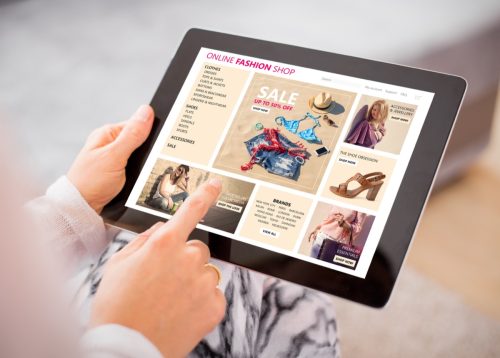
We’ve all been there: We do some virtual window shopping, adding items to our cart that we’d love but can’t really afford. As a budgeting technique, Woroch recommends emptying the cart out when you’re done.
“Some retailers send emails to customers who left items in their carts, reminding them to return back to their site to purchase and some may even offer a coupon to entice further!” Don’t get caught impulse buying when these emails come through.
14. Stay on top of subscriptions.

Even if they’re just $5 or $10 a month, unused subscriptions can really add up over time.
“Whether it’s grocery delivery like HelloFresh or a streaming service like Netflix, it is always important to check your card statement and make sure you don’t have any forgotten services after you signed up for the free trial period,” advises Bloom.
She suggests assessing your subscriptions a few times a year to see if you really need them all.
15. Be mindful of online grocery delivery.
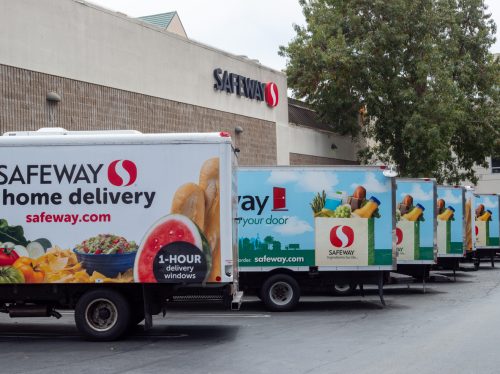
Online grocery delivery sure is convenient, but as Godwin notes, it usually includes a fee or service charge (and tip), which can add up over time.
“Looking for options that are a little less convenient (Store Pick Up, Curbside & Click and Collect) could be a better decision as most of these services are free to shoppers,” he says.
16. Don’t be shy about returns.

Return policies seem to get more and more flexible, and Bloom says this is a great way to save money while still being honest.
“If you see something go on sale or discount after you bought it full price, don’t be afraid to rebuy and return the full-priced item. Most return policies are hassle and cost-free!”
READ THIS NEXT: Never Use Autopay for These 6 Bills, According to Financial Experts.
17. Or price adjustments.

Perhaps even easier than returning and rebuying is simply requesting a price adjustment.
“Many stores offer price adjustments on recently purchased items that go on sale within a certain period after purchase— typically within 14 days, but it can be as long as 30 days after purchase,” explains Woroch. For example, Costco will do price adjustments within 30 days.
“Capital One shopping has a feature that will track price drops for online purchases linked to your email and alert you if you qualify for a credit,” she says.
And PriceBlink is a browser extension “that provides instant price comparison whenever you’re looking at a product online showing you sites that sell the same item for less,” she adds.
18. Or price-matching.

Depending on the product and other stipulations, stores from Best Buy to Target will price match. If you’re about to make an in-store purchase, Godwin recommends using your phone to see if there’s a better price elsewhere.
19. Trade kid’s clothing.

If you have kids, you’ll know that outfitting them can be costly, as they’re constantly growing. This is why Woroch recommends using The Swoondle Society.
“They send you a bag that you fill up with clothing your kids don’t fit into or just don’t like, and then they’ll give you credit for each item you sent in, which you can then use to get like new clothing from other parents,” she explains. “There’s a small trade fee to sign up for the annual membership, but it’s a small price for huge savings!”
20. Buy generic.

Going generic is a surefire way to get necessities at a fraction of the price. For example, you can spend half as much money while still getting the same quality on aluminum foil simply by going with Target’s Up & Up brand instead of Reynolds Wrap.
In fact, in a March 2023 article for CNET, food and travel writer Pamela Vachon found that, by buying generic, “it’s about 40% in total savings across various grocery categories.”
This applies to medications, too. According to the U.S. Food & Drug Administration (FDA), “FDA-approved generic medicines work in the same way and provide the same clinical benefit and risks as their brand-name counterparts.”
READ THIS NEXT: You Can Get Vouchers for Free Items at Kroger—Here’s How.
21. Be smart about shopping on Amazon.
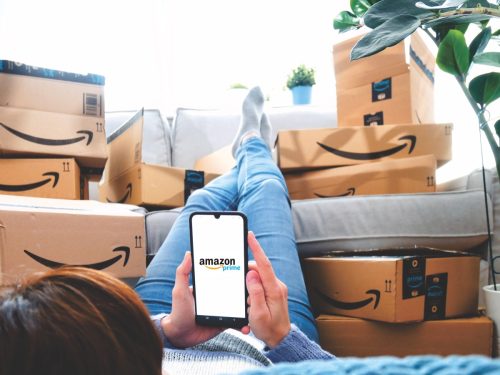
For most of us, clicking “buy now” on Amazon is all too easy—and cheap. But you could actually be saving a lot more on the e-commerce site.
One way to get deals is by shopping on Amazon Outlet, a section of the site that sells overstocked items. “We’ve seen these discounts reach up to 81 percent off,” Katie Roberts, consumer analyst with DealNews.com, previously told Best Life.
There’s also a hack that’s popular on social media where shoppers can search for “coupons and promo codes for discounts” to find all items with current a promotion.
22. Don’t forget the senior discount.

If you’re in your 50s or 60s, there are many stores that offer a senior discount. For example, shoppers 60 and older get 15 percent off at Kohls on Wednesdays, and those 55 and older can get 10 percent off at Michael’s every day.
Check out your favorite stores’ policies so you know when and how to take advantage of these deals.
23. Wait 24 hours—or 30 days—to make purchases.

Whenever you see something that you feel like you absolutely need, force yourself to wait before making a decision about buying it.
“If you’re shopping online, implement the 24-hour rule. When you find an item you like, especially if it’s on the expensive side, add it to your cart and log off,” explains Alev. “Make it a goal to wait 24 hours before making the purchase—the point is to give yourself time to think about it and avoid an impulse or emotional purchase.”
J. D. Roth, creator of the website Get Rich Slowly, also suggests waiting 30 days if it’s not a time-sensitive purchase. “If, at the end of a month, the urge is still there, then consider purchasing it,” he writes.
24. Use the FOMO test.
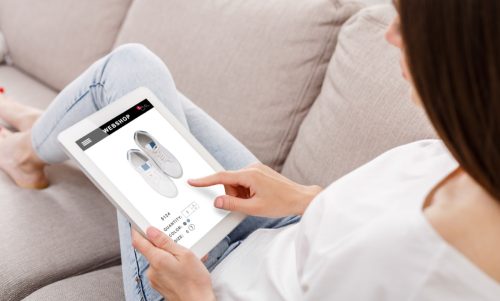
Another tactic to avoid impulse purchases is the FOMO (fear of missing out) test, says Alev.
“When you’re about to hit ‘buy,’ ask yourself if you’re buying something because you truly want or need it, or you’re doing it because it’s trendy, or other people are buying it too and you want to keep up,” she shares. “Will you still be excited about the item in two weeks, two months, or two years from now? The last thing you want is for peer pressure to cause you to overspend.”
Best Life offers the most up-to-date financial information from top experts and the latest news and research, but our content is not meant to be a substitute for professional guidance. When it comes to the money you’re spending, saving, or investing, always consult your financial advisor directly.